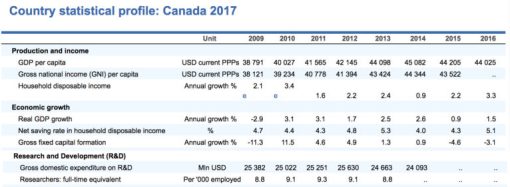SR&ED and the Canadian Productivity Paradox
Reference Article (>5 Years Old)

Raising living standards and improving productivity are central goals for countries around the world. In order to improve living standards and productivity; “innovation and technology play an important role in advancing economic potential.”1 However, what is the Canadian government doing to help boost its rankings in innovation, and how does Canadian productivity compare to the world at large?
Canada: Slow Progress
The Organization for Economic Co-operation and Development (OECD) statistics show Canadian productivity as slowly increasing, as illustrated by the graph below. (Note it is Ireland that is dramatically out-performing all the other countries.)2

Canadian GDP per capita and spending on Research and Development (R&D) have both seen decreases, as shown in the table below.3

OECD Canadian Economy Statistics 2009 – 2016
The fall in GDP is fundamental to the Canadian productivity paradox – in spite of Canada’s advantages and enormous potential, economic performance lags.
Measuring Productivity Success: Key Indicators
The correlation between spending on R&D and an increase in productivity can be seen in the illustrations above – when funding increased after 2010, there was a significant rise in productivity. When R&D funding was cut in 2013, however, there is a marked drop in productivity in 2014.4
Improvements in productivity, a reflection in part of spending on research and development that sparks business innovation, occur through competitive pressures and effective government incentives. As a result, it is essential for the Canadian government to support sound funding programs that bolster productivity and sustain competitive advantages for Canada as it contends on the world stage.
The OECD believe “The [Canadian] federal government should re-examine the SR&ED tax credit […] and reconsider the balance between direct and indirect support for R&D,”5 however, David Ross (CEO of Ross Video) commented in the Globe and Mail that the “SR&ED program […] decreases the cash returned to companies as they grow or become mildly profitable. The original idea was to spark innovation and startups, but looking at the stats [Canada doesn’t] have an innovation problem – we have a commercialization of innovation problem.”6 (Read more summaries of news articles regarding government R&D spending and the SR&ED program on our SR&ED in the Media page.)
SR&ED: Too Complex a Process?
In Canada, the Scientific Research and Experimental Development (SR&ED) program is the largest federal tax incentive that provides indirect funding for research and development work.7 The SR&ED process – from application to the administration of funding – can be complex, and historically, reviews have called for simplification.
However, although the OECD have suggested the Canadian government should “evaluate R&D subsidy policies to ensure that they are providing value for money,” the OECD have also stated:
Governments worldwide increasingly rely on tax incentives in addition to direct support measures (e.g. grants) to promote R&D in firms and encourage innovation and economic growth.
The federal SR&ED program remains an important incentive that encourages R&D in Canada. It offers over $4 billion dollars annually to small-, medium-, and large-sized firms that meet it’s complex criteria, which makes it amongst the most generous in the world. Combined with the generous provincial programs companies can recover up to 82% of their qualifying R&D expenses.
Looking Forward: Shifting the Productivity Paradox
As Canada moves forward, improving the current rate of efficiency in producing output is necessary if Canada wants to remain competitive in global markets.
Overturning the productivity paradox requires breaking new ground on the productivity frontier. Adding value to goods and services through innovation would give Canadian companies an edge in accomplishing this task. This would ultimately drive income growth for Canadians.
In order to overcome the productivity paradox, it is imperative that Canadian businesses not only innovate, but that they are able to do so efficiently, through accessing incentives that the SR&ED program provides. Technologies can be improved; methods can be streamlined; and discoveries can be made. Having Canadian businesses leverage SR&ED incentives could translate into an increased rate of productivity growth, a competitive portfolio of products and services, and a better educated and technologically-enabled country.
Do you have your own opinions on how Canada can improve its innovative cultures? Is the government doing enough, are private businesses doing enough?
Connect With Us!
Share your thoughts by commenting below or joining the conversation on our LinkedIn page, Facebook page, or via Twitter.
